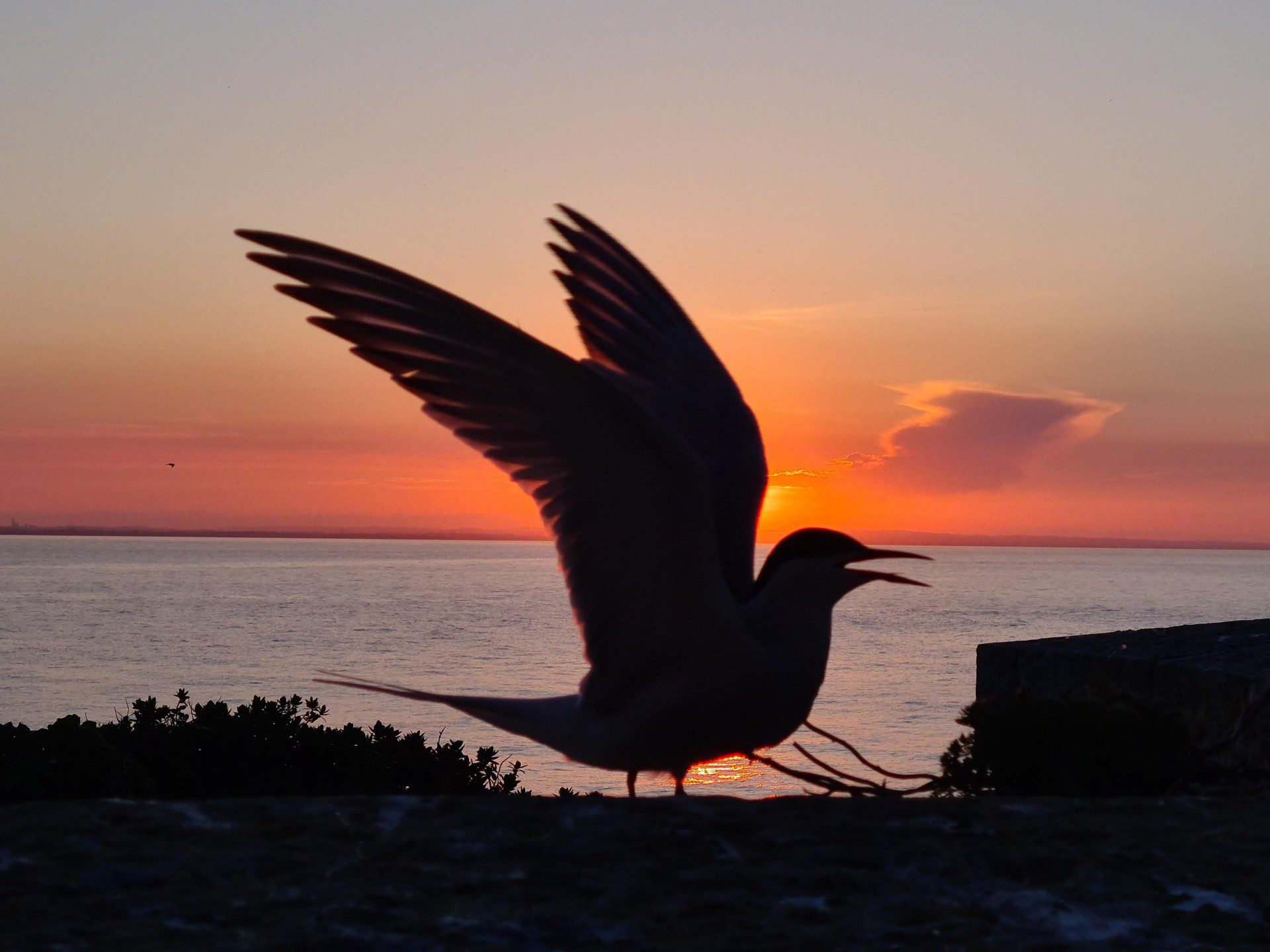At the end of our last update, we mentioned that the terns had just begun landing on the island. Now, it’s hard to imagine a time when they weren’t here! While we’ve been very busy monitoring the island’s changes, the terns have been even busier. Over the past two weeks, they have transitioned from cautiously inspecting potential nest sites to enthusiastically and vigilantly protecting their nests and eggs.
We can confirm that all three species—common, Arctic, and Roseate Terns—are nesting on the island, with different pairs at various stages of nesting. Some terns have already begun incubating their full clutches of three-egg nests, while others are still selecting suitable areas to settle down.
First, let’s check in with each species of tern.
- Common Tern
Common Terns favor open nesting sites, resulting in our gardens, paths, and areas cleared of tree mallow being filled with their nests. Every morning, when we leave the keeper’s cottage to start work, we encounter new nests and eggs along the way to each study site.
Common Terns are much bolder than the Roseate and Arctic terns and fearlessly protect their nests at all costs. The amount of guano (or seabird poop) on our hats and jackets increases tenfold when we survey the garden study areas as they are full of very defensive Common Terns protecting their eggs. We absolutely love to see it, as this behavior helps them defend against potential predators like Herring Gulls and Greater Black-backed Gulls.
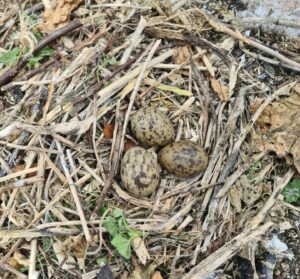
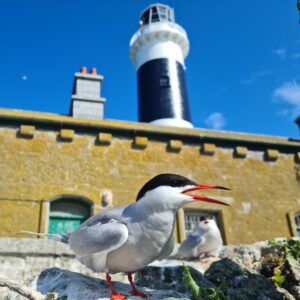
- Roseate Tern
Roseate Terns are a fan of the deployed nest boxes, but that doesn’t mean that they exclusively nest there! We have seen some Roseate eggs in bizarre places so far, including on top of an occupied nest box! Aside from the nest boxes, they love nesting in vegetated areas meaning that the areas where we left rows of tree mallow are very popular with Roseate Tern pairs.
Some of our study areas became occupied faster than others. In one study area to the south of the island, nearly all of the boxes are occupied by Roseate pairs, most of which have two, and sometimes three, eggs. Additionally, there are plenty of open nests around the nest boxes among the scurvy grass and vegetated areas. A breeding Roseate couple takes turns incubating the eggs and will continue to do so until they hatch. Occasionally, when a parent is relieved of their incubation duty and leaves the nest box, they stretch their wings and legs. I think all of us who have worked office shifts can relate to that!
The incubation period of Roseate Terns is approximately 23 days, meaning that we will be expecting our first Roseate egg to hatch around Friday the 7th of June.
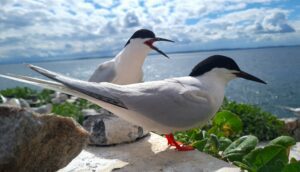
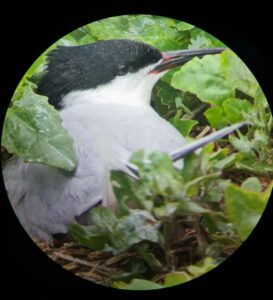
- Arctic tern
While the island hosts fewer numbers of Arctic Terns compared to the Common and Roseate Terns, we are very happy to see that there 5 to 6 breeding pairs of Arctic Terns are nesting on Rockabill again this year. Compared the the Common Tern, the Arctic Tern is smaller, with a smaller head, neck, and bill, and slightly narrower wings that appear forwardly placed. These terns have very short legs and adults feature a blood-red bill, usually without a dark tip. Additionally, they have greyer underparts than the Common Tern, with some contrast at the cheek. We have confirmed the presence of 12 Arctic Terns and 5 Arctic nests so far.
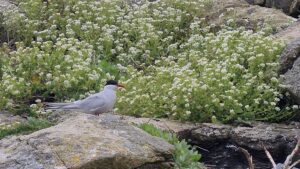
When we are not checking on the tern nests in our study sites, we are busy in ring reading. We are getting great use out of the 5 hides that we set up around the island. In the hides we can use the scopes and binoculars to read rings on as many birds as possible. By reading these rings we can gather information on the birds’ origins, ages, nesting locations, mating patterns, changes in nesting success over time, and sometimes, their migration patterns when the same rings are spotted away from Rockabill.
We haven’t forgotten about the other nesting seabirds spending the summer with us! Every day, we make sure to check on the Black Guillemot and Kittiwake breeding pairs, who have been just as busy as the terns, building nests and incubating eggs.
- Black Guillemot
Most Black Guillemot pairs have already started incubating their eggs. Black Guillemot eggs are much larger than tern eggs and have a purple- blueish hue to them. We have been finding Black Guillemot eggs in the nest boxes that we deployed under the helideck and to the south of the island but we have also been finding plenty of eggs in dark cavities all over the island. Black Guillemot parents incubate their eggs for longer periods than terns, with both parents typically sharing incubation duties for 28 to 32 days.
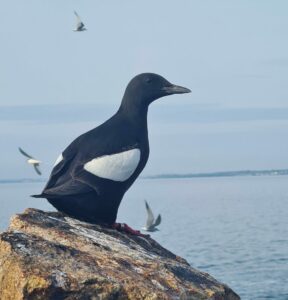
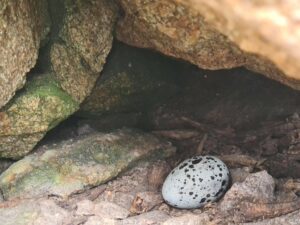
- Kittiwake
The Kittiwakes were the first seabirds to to greet us when we arrived on Rockabill. They have had a longer settling-in period than the terns and the Black Guillemots and took their time building up their nests, which are situated on the ledges of steep cliffs. The nests are bowl shaped and made up of seaweed, other marine vegetation, feathers, barnacles, and mud. Their nests were progressing gradually until one day, after a particularly stormy morning, the nests had progressed significantly! We spotted our first kittiwake egg on the 27th of May, nearly two weeks after our first Common Tern egg.
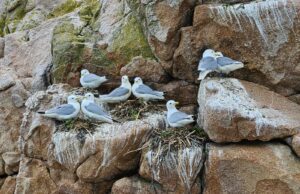
- What’s Next?
Before the eggs hatch we have a big task ahead of us. Next week, we will be joined by Project Manager Dr. Stephen Newton and will start this season’s big nest census. While us wardens have been keeping count of all of the nests in specific plots around the island, that still leaves thousands more nests around the rest of the island left to be counted. Once the nest census is complete, we will know how many breeding pairs, nests, and eggs, we have on the island. After that, it won’t be long until the first egg hatches!
This year’s work to protect and monitor the terns and other breeding seabirds on Rockabill would not be possible without the support from the National Parks and Wildlife Service and the cooperation of the Commissioners of Irish Lights.
That’s all until the next ternabout! We will be sure to check in again after the nest census is complete!
-Emma, Rochelle, and Kyle

